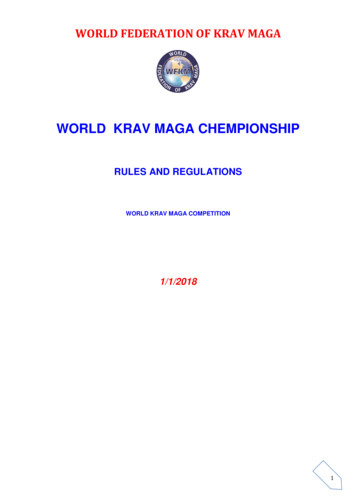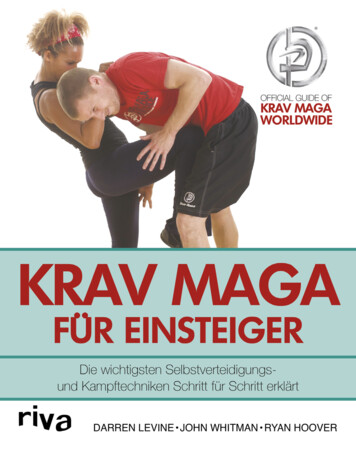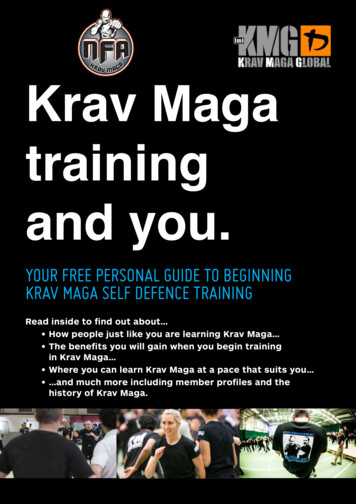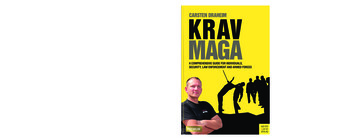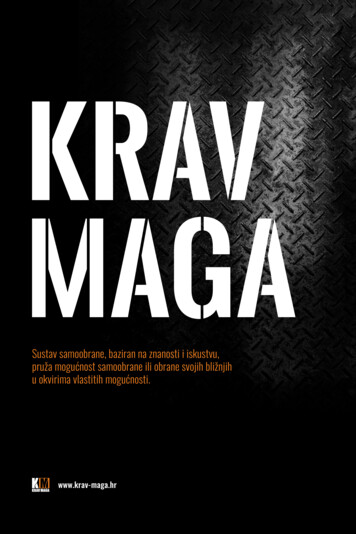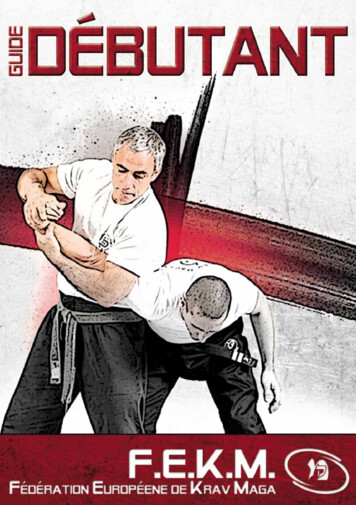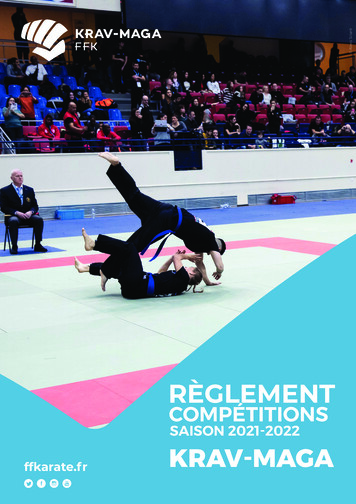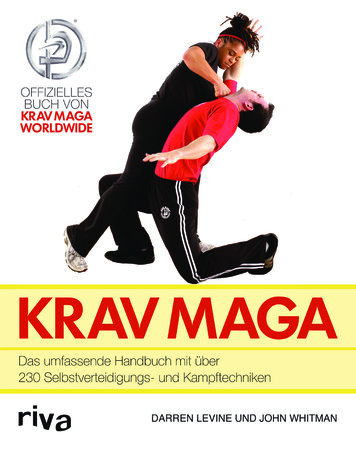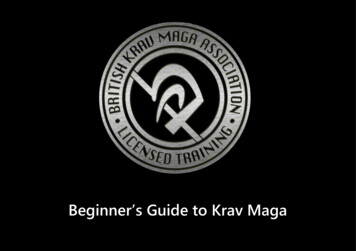
Transcription
Beginner’s Guide to Krav Maga
Get a head start in your trainingWelcome to Krav Maga. In the following pagesyou’ll find essential information to help you get agreat start in Krav Maga this New Year. Thishandy beginner’s guide covers: What is Krav Maga? Who can learn Krav Maga?The controlled risk of Krav Maga trainingYou and your fitness levels How to get startedChoosing a good school What it’s like in classVital kitThe Krav Maga grading systemRead on for more information. Or to book a freesession at your local club, visit this link.
What is Krav MagaKrav Maga is a hand to hand combat system developed in the Second World War. Since its creation, it hasproved extremely effective in conflicts around the world and in the hands of ordinary people andprofessionals alike. It’s so successful that it is now required learning in over 500 military and lawenforcement agencies globally.It’s important to understand that Krav Maga is not a martial art. It is a combat system. It is easy to learnand has proven, consistent results in many different operational theaters. Its core teaching is one ofsimplicity – arming the ordinary person with a series of simple, instinctive movements that will work underthe pressure of a real assault. The key strength in Krav Maga is not simply in its techniques – but rather inthe methodology and the psychology of learning. A good instructor will give you a set of basic techniquesand then build up your training until you’re testing those techniques under safe, but significant pressure,giving you the confidence that you could repeat what you’ve learnt in the real world, when your life wasunder threat.Taught well, it is a system trusted by a wide variety of people: soldiers, close-protection officers, lawenforcement, civilians and security staff. Nothing else in the world has the battle-tested, proven credibilityof Krav Maga and nothing else is in such high demand. True self defence begins and ends with theteachings of Krav Maga.
Who Can Learn Krav MagaAnyone can learn Krav Maga. Most instructors willonly teach adults, due to the sometimespressured nature of training which can involverole play of violent encounters, bad language, etc.There is no upper age limit and most health issueswill not prevent you learning provided you are upfront with your instructor about these issues andyou agree to follow the instructor’s guidance andstart gradually, building up fitness and strength ina measured and sustained manner. Any successfulKrav school will have a wide range of studentstraining regularly, including men, women, peoplefrom all age groups – though the average isusually around 30 – 40 – civilians, police, militaryand security staff, beginners and experts. As longas you come with the right attitude, the door isopen to anyone.3
Controlled Risk in TrainingAll combative training carries a level of risk, butthe risk in a Krav Maga class is carefully controlledand managed to ensure that you have anauthentic but injury free experience. d in coaching many hundreds of peopleof all abilities. They will be first aid trained andwill have extensive understanding of thephysiology of physical training. It is their job tomake sure you receive the best instructionwithout coming to harm. There is frequentlysparring involved in Krav Maga lessons, but it isnearly always at a low level of contact which willnot cause injury to you. Of course, during thecourse of training, the odd bruise is expected andyour body will ache after training, particularly forthe first month or so. But serious injuries are veryrare – Krav practice is statistically much saferthan Squash, Football, Rugby and many otherpopular sports.4
How Fit Do You Need to Be?Krav Maga classes involve a lot of physicalexercise – it is part of the Instructor’s job to makeyou fit and physically strong so that you are ableto confidently carry out the techniques you learn.Krav will make significant improvements to yourfitness and is very successful at bringing peopleback to fitness and losing weight etc. But thisdoes not mean you need to be fit to start. All youneed to do is start slowly, working up to fitnessand strength in a measured, gradual fashion. Allyour classmates have been through the sameexperience and you’ll find them supportive andhelpful both in class and out of it, for advice oruseful experience.3
Choosing a Good Krav SchoolBe warned that as Krav Maga gains in popularity there will be more and more unqualified people claiming toteach authentic Krav Maga. We are seeing a real growth in 2 or 3 day instructor courses, churning outinstructors that have no experience or proven training background in Krav Maga. Typically, these instructors willalready run martial arts schools and are seeking to add Krav to their programe in order to make extra money.You cannot expect good or even real Krav Maga training from instructors and schools like these. To be sure ofyour training, seek the big brands in the business – any instructor flying the flag of a major brand will havebeen through a qualification and training program tougher than you can imagine and will have proven,professional capabilities not only in Krav Maga but in the psychology and physiology of teaching Krav Maga.Remember, it’s one thing to practice a system and quite another to be able to teach it.Ask the instructor about his or her lineage. There should be a clear line back to the source of Krav Maga. Acredible instructor has years of training experience as well as an 18-24 day instructor qualification process thatdemanded over 200 hours of tough, contact Krav Maga, before they were awarded their certificates.You wouldn’t learn to swim from someone who had never been in the water.Established, credible Krav associations across the world include : British Krav Maga; Krav Maga Global;International Krav Maga Federation; Krav Maga Worldwide.TOP TIP: All BKM schools offer free beginners sessions. To get involved, all you need to do is contactyour local school and ask for a place. Your instructor will be happy to get you booked in.
What it’s Like in ClassMost people make the same comment aboutcoming to Krav Maga, especially those who’vecome from other systems. It’s a really greatatmosphere, full of supportive people, a truly egofree environment. If you ask a Krav instructorwhy this is, the consensus is that because we allexercise hard and classes are hard work, peopleafter an ego trip and an easy ride are selectedagainst naturally. A good class will demand sweatand effort from you, and in return you will findKrav groups to be really great trainingenvironments and you’ll find the experienced folksreally happy to train with you and offer you theirtraining wisdom, helping you to reach your ownpotential. Frankly, if you don’t find this in yourclub, find another club!3
The Kit you NeedFor a beginner’s session, all you need are loosefitting clothes – tracksuit bottoms, t-shirt andtrainers are best – and a bottle of water to drinkwhile you train.Experienced Kravists progressing from beginner’straining will need 16oz boxing gloves, agumshield, shin protectors and a groin guard. Allthese things can be purchased cheaply from majorsports or online retailers. For more information,ask your instructor.
Are There GradingsAre There Tournaments?Yes. Different associations have different systemsof ranking, but all have some system of gradingassessment. It is, however, a very differentballgame than traditional martial arts. Most artsrun on a time-served basis where students willtypically grade every 3 months to black belt.Often grading assessments in the arts are short,simple affairs requiring a little pad work, light nocontact sparring and patterns. In contrast, yourfirst grading with the British Krav MagaAssociation (BKM) will take around 4-5 hours andfor many will be the hardest physical undertakingthey have ever attempted. Gradings are notcompulsory – some students do not choose to dothem – and if you decide not to grade it won’taffect what or how you are taught. If you dograde and pass, you will not be awarded a belt. Allstudents in the class are the same and the onlyway of telling who is who is to train with them.This fosters an equal, supportive and ego-freeenvironment. The gradings are very much for youto test yourself. Passing one will be anachievement you will hold for the rest of your lifeand it will stand you in good stead if you everneed to use your techniques in the real world.No. There are no competitive events in KravMaga. Most competitive events in the martial artsencourage behaviours and practices that are notconducive to real world survival. For example,roughly 80% of all violent encounters see thevictim outnumbered at least two to one against,while most competitions are contested one onone. The job of a Krav Maga instructor is to trainyou to survive on the street, in the heat of realcombat, not to bring home trophies and medals.3
What Now?If you want to try Krav Maga for yourself, contactyour local instructor. Most schools offer freebeginner sessions designed to offer you a chanceto dip your toe into the Krav world and meetsome of the people who practice it. Get involvedtoday and find your local school here.Krav Maga can be a life changing journey. As aninstructor, I’ve had the privilege of training withand teaching hundreds of inspirational anddeicated people, many of whom have becomegreat friends. I’ve seen people totally change theirbody shape and their mental shape through theforging of tough training. And I’ve seenprofessionals come home from conflict with storiesof how the training protected them and others intheir charge.Learning Krav Maga may be the best thing youever do.Good luck in your training and keep safe.Will Bayley - BKMA Graduate Instructor
Copyright 2016 British Krav Maga Association
Or to book a free session at your local club, visit this link. What is Krav Maga Krav Maga is a hand to hand combat system developed in the Second World War. Since its creation, it has proved extremely effective in conflicts around the world and in the hands of ordinary people andFile Size: 1MB
